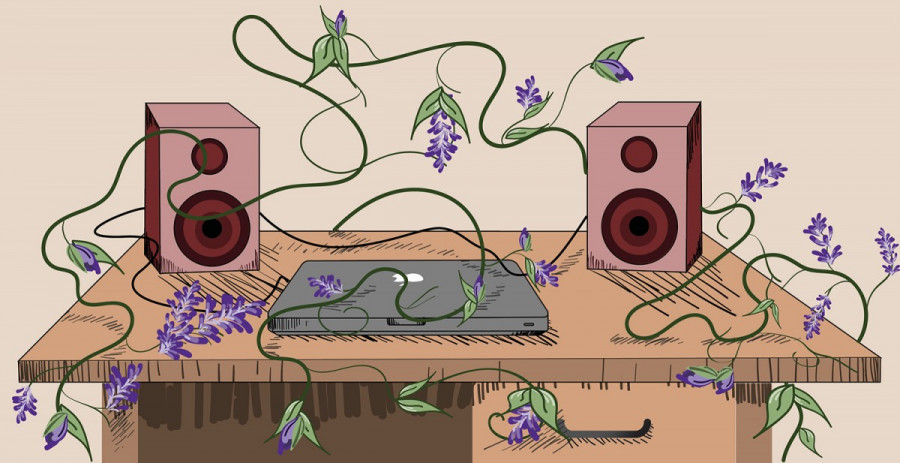The Sound of Silence: Gender Imbalance in Electro Acoustics
University Programs Begin to Change
Less than five per cent of existing sound producers and engineers in the recording business are women, according to the Women’s Audio Mission, a recording studio built and run by women.
Similar to the gaming world, electroacoustics—a field that involves the creative practices and processes in electronic music, computer music and sound art—is considered to be yet another boys club. Women who work in this field tend to continuously try and prove themselves, while men don’t necessarily trust their technological abilities.
In a domain that is dominated by the male gender, can anybody hear these women?
Canadian electronic music composer Freida Abtan points out that there are very few female artists visible in the experimental electronic music scene. Abtan describes that most electronic music social networks tend to privilege male inclusion and success.
“For most, there is a significant social component, not only in learning how to produce electronic music, but also in the performance and marketing of it,” Abtan says.
Social situations, such as band practice or musical experimentation, will often exclude women unless they are vocalists or a band member’s girlfriend. As a result, women in the electronic music genre are then limited to roles that ultimately prohibit their capability of expanding their skills in an electronic creative practice, Abtan says.
Electroacoustics is a DIY culture, Abtan explains, and the necessary skills to be successful in the field are passed around closed communities and friendship networks which are often predominantly male. As a result, solo female electronic artists have difficulty acquiring the skills needed to be able to market themselves and perform onstage.
The problem remains as women are consistently closed off by figurative gender barriers and social structures. Moreover, they are unable to join a skills-sharing network that has long been established as predominantly male.
“For many young women, entering an electronic music DIY network is as awkward as trying to make friends with the school yard boys in first grade,” Abtan says.
Women have to rely on either independent learning, skill-sharing networks, and workshops amongst other women and gender nonconforming individuals, or academic training—which tends to fosters an electroacoustic boy’s club through exclusion.
Montreal’s four universities include different electroacoustic music programs. Yet the problem remains in its equal representation of women in their courses. In fact, the ratio is about one female student to about 10 male students.
For Joanne Mitrovic who graduated from the electroacoustics program at Concordia University, being the only woman in a classroom of 50 was a common theme.
“In class, you have to prove what you know even though you’re still kind of learning,” Mitrovic says.
Yet when a female classmate and friend of hers dropped out of the program in her third month because of verbal harassment from other male students, Mitrovic knew that something had to change.
“I ended up going to the teacher asking if they could do something about this because she clearly [didn’t] feel comfortable in class,” Mitrovic said. “They didn’t do enough.”
In fact, Mitrovic’s friend wasn’t the first student who dropped out of the program for similar reasons without support from fellow professors.
She reached out to then-music chair Liselyn Adams to try and organize a meeting with the department. Together, Mitrovic, Adams, and professors not only discussed possible solutions to get more women enrolled in the electroacoustics program, but also ways to get them to stay.
It was clear that affirmative actions were needed to influence the curriculum which would hopefully in turn influence the field. They discussed inviting more women and racial minorities as guest speakers, as well as making changes to the syllabus that would help expand the world of electroacoustics beyond the dominantly white male territory.
That same year, Mitrovic organized Loudspeakers, a conference focused on gender and race in audio technologies and music production. Speakers included Julie Slick of the Adrian Belew Power Trio and Kathy Kennedy who is the co-founder of Studio XX, a feminist artist-run centre for those marginalized in the digital arts.
“For many young women, entering an electronic music DIY network is as awkward as trying to make friends with the school yard boys in first grade.” —Freida Abtan
Having the conference helped administer a workshop that pushed for an inclusive environment, while providing a safe space for women and visible minorities to share and gain skills in sound engineering.
Mitrovic’s campaign for gender balance in electro acoustics would theninspire a larger project for the principal of the Simone de Beauvoir Institute at Concordia, Kimberly Manning. This year, Manning is continuing Mitrovic’s work in her Critical Feminists Activist group, C-FAR, through her six-credit course called the Feminist University. Students enrolled in this course use social action research methodologies—a problem solving technique in a group or with the community to try and tackle a specific problem or issue.
“The project is special for a couple of reasons. First, it’s pretty much the first pilot project involved in [C-FAR],” Manning said, underlining that the effect was really launched by Mitrovic, thanks to her Loudspeakers conference. “Another reason is Eldad [Tsabary] himself [and] his willingness to support [Mitrovic] and for taking a look at what’s missing in the curriculum.”
Eldad Tsabary, an assistant professor of music at Concordia was inspired by Mitrovic to expand his research on the gender imbalance and misrepresentation of women in the electroacoustic industry.
“This problem [is] like a feedback loop. It started because of gender roles in history,” Tsabary said in an interview with Concordia University News. “Men were better positioned to establish and grow [in] this field, but women made important contributions right from the start. The shortage of visible role models made it less inviting for many women.”
Tsabary is also co-editing the first book for the curriculum on the history of women in audio—a missing piece to the solution puzzle.
And while changes are slowly taking place within the department and university, the results are gradually moving forward as more women are enrolling in the program.
“More recently, the [dynamics] have been changing a bit,” Mitrovic said. “When I was [at Concordia], I think there was about five per cent. Now it’s up to maybe 15-20 per cent so it’s definitely improved. Not much, but it’s improved.”
It may seem that little progress is being made, but progress all the same continues from the bottom up through collaborative youth groups like Rock Camp for Girls Montreal.
Rock Camp for Girls Montreal is a space for young girls and gender nonconforming youth to learn and teach each other skills in music production and direction. It’s a skill-sharing network that fosters a safe, open, inclusive and empowering platform for learning and performing.
“[We] create these workshops where we teach these girls and gender nonconforming youth about sound, about how to use the system board just to get them really into it,” explained Taharima Habib, who is involved with the camp.
For Habib, Rock Camp for Girls Montreal is a small stepping stone towards balancing race and gender dynamics in the music industry.
“When campers come in every day, the first line they see or communicate with is the organization committee that is built by women, gender non-conforming, queer and most of them, 80 per cent of them, being people of colour.”
However, one thing the camp struggles with is finding these individuals to represent the visible minorities in the industry.
“None of us are well versed—we don’t have a lot of sound technicians that are women or gender nonconforming,” Habib said. “So, the aspect that is really important to music, especially today, is something that we really put our energy into and finding someone who really fits in to being a role model.”
Habib hopes that the girls are inspired by the people who teach them the music and technical skills and that it will encourage them to continue outside of camp or even in school.
“Afterwards, they can become a sound engineer and not think that [this position] is still for guys.”
Between the women and men involved in trying to break these barriers, change in the gender dynamics is getting stronger, louder, and hopefully stays constant like lyrics that get stuck in your head.
Like the lyrics that is often in Habib’s head from “For Me, For Her, For You,” a song by a group of campers who called themselves The Wild Witches:
“We’re not fighting you
We’re fighting all the things you put us through
Why do you need so much space in the room?”


_600_832_s.png)

1_600_375_90_s_c1.jpg)


2_600_375_90_s_c1.jpg)